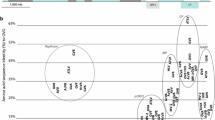Abstract
A survey was performed on a Vitis cultivar collection in Stellenbosch, South Africa. Metaviromes were generated for each cultivar, using an RNAtag-seq workflow. Analysis of assembled contigs indicated the presence of two putatively novel members of the genus Vitivirus, provisionally named "grapevine virus N" (GVN) and "grapevine virus O" (GVO). Comparisons of amino acid sequences showed that GVN and GVO are most closely related to grapevine virus G and grapevine virus E, respectively. The incidence of these novel viruses within the sampling site was low, with GVO and GVN associated with only five and two cultivars, respectively, of the 229 sampled.

Similar content being viewed by others
References
Gbejewoh O, Keesstra S, Blancquaert E (2021) The 3Ps (Profit, Planet, and People) of Sustainability amidst Climate Change: A South African Grape and Wine Perspective. Sustainability 13:2910
Martelli GP (2018) Where grapevine virology is heading to. In: Proceedings of the 19th congress of the International Council for the Study of virus and virus-like diseases of the grapevine (ICVG), Santiago, Chile, 9-12 April 2018
Fuchs M (2020) Grapevine viruses: a multitude of diverse species with simple but overall poorly adopted management solutions in the vineyard. J Plant Pathol 102:643–653
Galiakparov N, Tanne E, Sela I, Gafny R (2003) Functional analysis of the grapevine virus a genome. Virology 306:42–50
du Preez J, Stephan D, Mawassi M, Burger JT (2011) The grapevine-infecting vitiviruses, with particular reference to grapevine virus A. Arch Virol 156:1495–1503
Engelbrecht DJ, Kasdorf GGF (1987) Occurrence and transmission of grapevine virus A in South African grapevines. South African J Enol Vitic 8(1):23–29
Goszczynski DE (2010) Divergent molecular variants of Grapevine virus B (GVB) from corky bark (CB)-affected and CB-negative LN33 hybrid grapevines. Virus Genes 41:273–281
Goszczynski DE, Jooste AEC (2003) Identification of divergent variants of Grapevine virus A. Eur J Plant Pathol 109:397–403
Rowhani A, Daubert S, Arnold K, Al Rwahnih M, Golino KV, D, Uyemoto JK, (2018) Synergy between grapevine vitiviruses and grapevine leafroll viruses. Eur J Plant Pathol 151:919–925
Rowhani A, Uyemoto JK, Golino D, Daubert SD, Al Rwahnih M (2016) Viruses involved in graft- incompatibility and decline. In Meng B, Fuchs M, Martelli G Golino D (eds) Grapevine viruses: Molecular biology, diagnostics, and management, Chapter 12. Springer, New York, pp 289–302
Al Rwahnih M, Sudarshana MR, Uyemoto JK, Rowhani A (2012) Complete genome sequence of a novel vitivirus isolated from grapevine. J Virol 86(17):9545
Goszczynski DE, du Preez J, Burger JT (2008) Molecular divergence of Grapevine virus A (GVA) variants associated with Shiraz disease in South Africa. Virus Res 138:105–110
Blouin AG, Keenan S, Napier KR, Barrero RA, MacDiarmid RM (2018) Identification of a novel vitivirus from grapevines in New Zealand. Arch Virol 163:281–284
Candresse T, Theil S, Faure C, Marais A (2018) Determination of the complete genomic sequence of grapevine virus H, a novel vitivirus infecting grapevine. Arch Virol 163:277–280
Debat HJ, Zavallo D, Brisbane RS, Voncina D, Almeida RPP, Blouin AG, Al Rwahnih M, Gomez TG, Asurmendi S (2019) Grapevine virus L: A novel vitivirus in grapevine. Eur J Plant Pathol 155:319–328
Read DA, Thompson GD, Swanevelder D, Pietersen G (2021) Detection and diversity of grapevine virus L from a Vitis cultivar collection in Stellenbosch, South Africa. Eur J Plant Pathol https://doi.org/10.1007/s10658-021-02380-y
White EJ, Venter M, Hiten NF, Burger JT (2008) Modified cetyltrimethylammonium bromide method improves robustness and versatility: the benchmark for plant RNA extraction. Biotechnol J 3:1424–1428
Shishkin AA, Giannoukos G, Kucukural A et al (2015) Simultaneous generation of many RNA-seq libraries in a single reaction. Nat Meth 12:323–325
Girardot C, Scholtalbers J, Sauer S et al (2016) Je, a versatile suite to handle multiplexed NGS libraries with unique molecular identifiers. BMC Bioinformatics 17(1):419
Nurk S, Meleshko D, Korobeynikov A, Pevzner PA (2017) metaSPAdes: a new versatile metagenomic assembler. Genome Res 27(5):824–834
Altschul SF, Gish W, Miller W, Myers EW, Lipman DJ (1990) Basic local alignment search tool. J Mol Biol 215:403–410
Wheeler DL, Church DM, Federhen S, Lash AE, Madden TL, Pontius JU, Schuler GD, Schriml LM, Sequeira E, Tatusova TA, Wagner L (2003) Database resources of the National Center for Biotechnology. Nucleic Acids Res 31:28–33
Rodriguez-R LM, Konstantinidis KT (2016) The enveomics collection: a toolbox for specialized analyses of microbial genomes and metagenomes. PeerJ Prepr 4:e1900v1
Hall TA (1999) BioEdit: A user-friendly biological sequence alignment editor and analysis program for windows 95/98/NT. Nucleic Acids Symp Ser 41:95–98
Stecher G, Tamura K, Kumar S (2020) Molecular Evolutionary Genetics Analysis (MEGA) for macOS. Mol Biol Evol 37:1237–1239
Maree HJ, Blouin AG, Diaz-Lara A, Mostert I, Al Rwahnih M, Candresse T (2020) Status of the current vitivirus taxonomy. Arch Virol 165:451–458
Adams MJ, Antoniw JF, Bar-Joseph M, Brunt AA, Candresse T, Foster GD, Martelli GP, Milne RG, Zavriev SK, Fauquet CM (2004) The new plant virus family Flexiviridae and assessment of molecular criteria for species demarcation. Arch Virol 149:1045–1060
Funding
David Read is grateful for the financial support provided by the National Research Foundation of South Africa under grant UID 104901.
Author information
Authors and Affiliations
Corresponding author
Ethics declarations
Conflict of interest
All authors declare that they have no conflict of interest.
Data availability
The data that support the findings of this study are openly available in NCBI public databases.
Ethical approval
This article does not contain any studies with human participants or animals performed by any of the authors.
Additional information
Handling Editor: Sead Sabanadzovic.
Publisher's Note
Springer Nature remains neutral with regard to jurisdictional claims in published maps and institutional affiliations.
Supplementary Information
Below is the link to the electronic supplementary material.
Rights and permissions
About this article
Cite this article
Read, D.A., Thompson, G.D., Cordeur, N.L. et al. Genomic characterization of grapevine viruses N and O: novel vitiviruses from South Africa. Arch Virol 167, 611–614 (2022). https://doi.org/10.1007/s00705-021-05333-2
Received:
Accepted:
Published:
Issue Date:
DOI: https://doi.org/10.1007/s00705-021-05333-2




